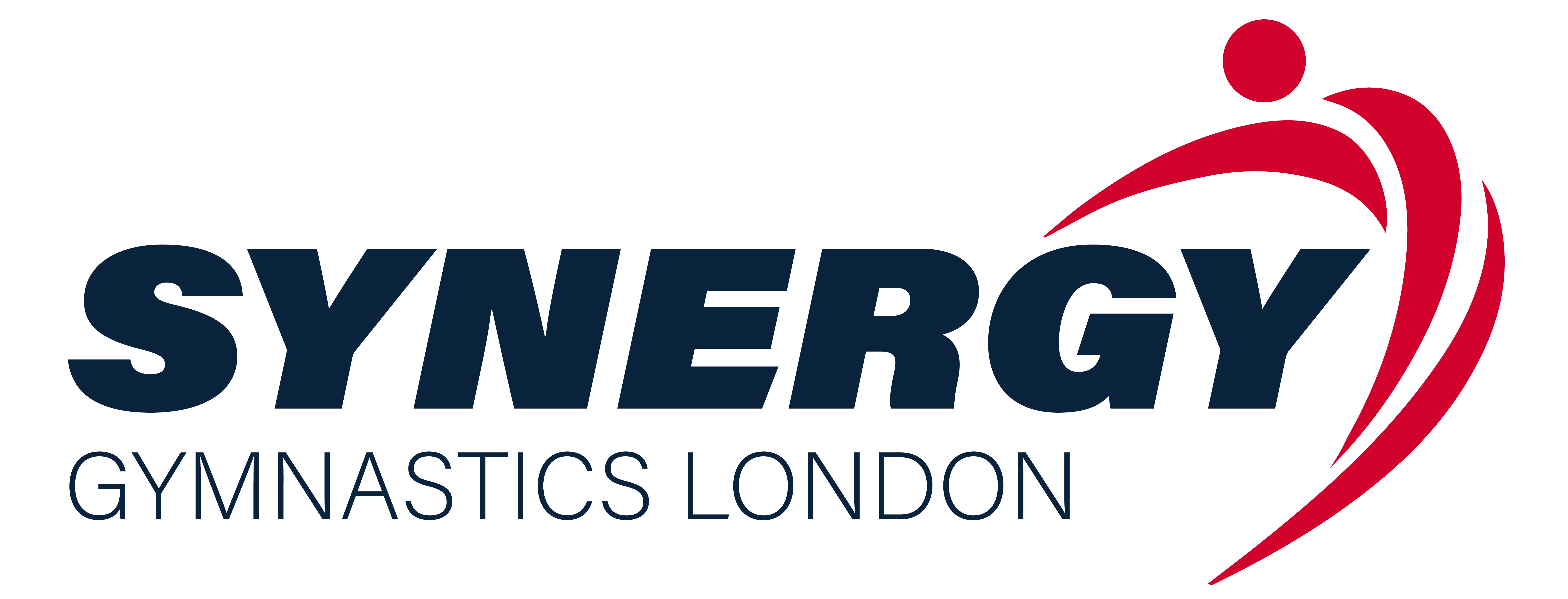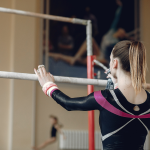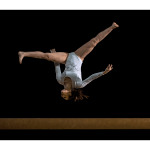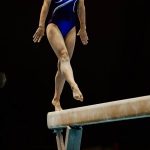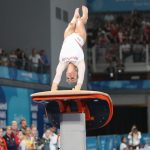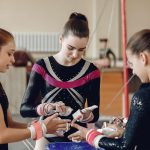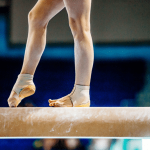One fundamental skill that gymnasts must master is how to do a round off. It’s a key component of backward tumbling passes and dismounts from the balance beam.
In this article, we will explore a step-by-step guide, proper technique, common mistakes to avoid and drills I have used as a Tumbling coach to improve the round off in gymnastics.
Disclaimer: This article should be considered generic advice and does not replace the need for professional coaching in a recognized facility.
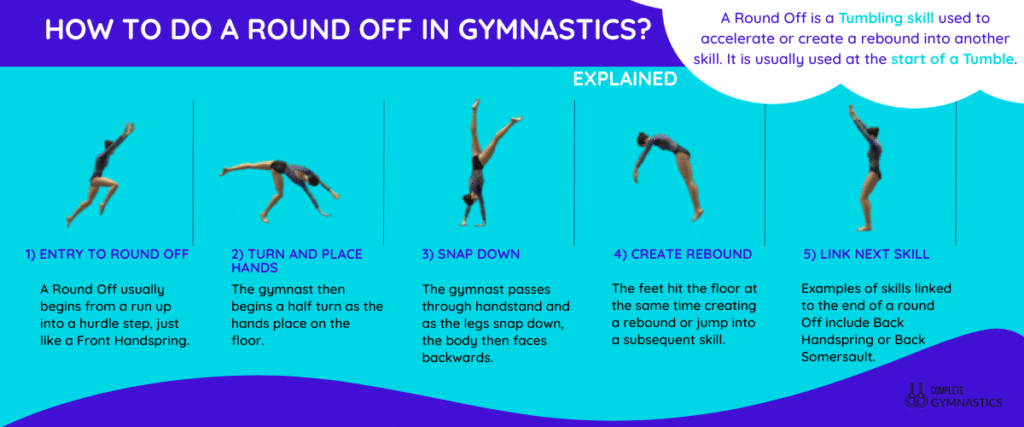
Thing You Should Know About A Round Off
The round off is a gymnastics skill that sets or ‘leads’ into other tumbling skills such as back handsprings or back tucks. It begins with the gymnast running forward and finishes with them facing backward ready to rebound into the next skill.
Many people describe a round off as a cartwheel with the feet coming together. In this article, I will explain why this concept is incorrect and will actually hold a gymnast back from mastering the round off completely.
By understanding and mastering the round off correctly gymnasts can enhance their tumbling skills and progress to more challenging passes.
As a performance-level Tumbling coach the round off is one move that I have spent years teaching using various drills and I am excited to share my experience with you!
How To Do A Round Off
Learning how to do a Round Off requires correct shaping, technique and the development of strength and power through conditioning.
Body Shaping
To execute a successful round off, proper body shaping and positioning are crucial. Before mastering the round off a gymnast will need to know the following basic shapes:
- Hollow Dish
- Lunge
- Landing Shape
A gymnast should also be able to hold a handstand. The round off passes through the handstand shape without holding it still but a gymnast should be able to perform the handstand with ease before mastering a round off.
Going Into The Round Off
When starting a tumbling pass, most gymnasts will run into their round off. In this situation, they should take long and powerful strides that will build up momentum and allow the gymnast to stretch out the entry into the round off. If the strides are too small it will be hard for the gymnast to extend their legs correctly.
It is also possible to start a round off from a standing position but the gymnast will have to jump forwards into the entry for the same reasons as the running version.
Whether from a run or a jump, the gymnast must ‘hurdle’ the last step so that the back foot lands first and the front foot lands second.
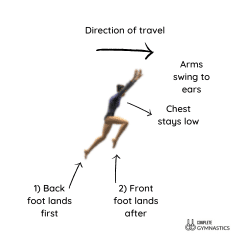
The approach and entry into a round off is exactly the same as Front Handspring until the point where the gymnast begins a half turn with their shoulders. Gymnasts that make the mistake of approaching their round off like a sideways cartwheel will slow down unnecessarily, therefore, reducing the amount of power they can create.
Foot Placement and Entry
The next step is foot placement. If you are struggling to keep your round off in a straight line this section is crucial. On a tumble track or air track the center line is usually already marked out.
If you are performing a left leg round off (left leg in front) then have your left foot come across your body to the right of the line very slightly whilst at the same time turning your hip slightly to the left.
Your right foot which will be behind you and about to swing over your head first, should be slightly to the left of the line.
In other words, your feet place on the opposite side of the line.

This foot placement will allow more room for the gymnasts shoulders to turn above the center line as they place their hands in the next step.
Hand Placement
There are two main variations to hand placement in a round off:
- T-Shape
- Both hands half turn
In my experience, gymnasts will naturally find their preferred option over time. The T-Shape is generally easier for younger gymnasts because turning both hands and shoulders half way around requires a good level of strength.
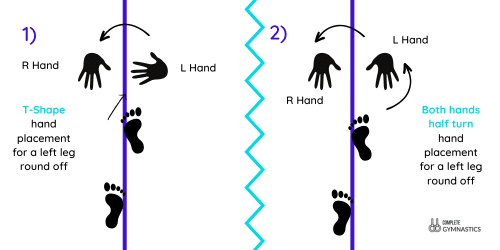
Personally, I find that gymnasts who can manage to perform the half turn correctly are able to snap down more efficiently out of the round off however if they lose shape and momentum trying to achieve this then it is pointless.
If you take away one thing from this section then it must be that hand placement for round off is different from cartwheel!
Handstand Phase
Once the gymnast’s hands make contact with the floor, they must initiate the backward rotation. The shoulders should lead the movement, followed by the hips and legs. It is essential to keep the body tight and maintain a straight line throughout the round off so that the gymnast can pass through a handstand shape.
Ideally, the gymnast’s legs will come together at the top but often to begin with a gymnast’s feet will only touch together later than that. There are some drills later in the article that will help fix this issue.
The illustration below shows a gymnast whose legs are still not together after the handstand phase. This will cause the snap-down to have less power.
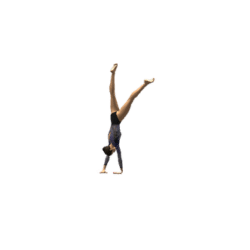
Snap Down
After the gymnast passes through handstand the legs will now start coming over the head and down towards the floor. The gymnast has to snap the legs and feet down as quickly as possible to create maximum power.
The legs should stay straight and the toes pointed during this phase which is also referred to as the Courbette Action.
Feet Contact with the Floor
When the feet contact the floor it is essential that the gymnast keeps good form and body tension in order to create a bounce or rebound from the floor. The purpose of the round off is to eventually lead into another skill so a round off that stops still at the end is not very useful!
When first learning a round off the gymnast may just jump up into the air as they will not be ready to add a more advanced skill such as a back handspring yet.
As time progresses the gymnast will need to learn where to have the feet contact the floor as it will change depending on which skill is to follow next.
The feet should snap for longer and come under the body when a gymnast is planning to link a skill that travels low and backwards immediately afterwards:
- Back Handspring
- Whip Back
However, they should create a short snap and have the feet contact the floor earlier for any skills that need to lift upwards instead of backwards:
- Somersault (all variations)
- Arabian
- Rebound Jump
Common Mistakes to Avoid
One common mistake in performing the round off is a lack of speed and power. Without sufficient momentum, it becomes challenging to execute subsequent skills. Gymnasts should focus on generating power through explosive leg drive and a quick snap down.
Incorrect Hand Placement
Improper hand placement can significantly affect the execution of the round off. If the hands and shoulders do not create enough turn this in turn will slow down the turn of the hips and the snap down.
Poor Body Alignment
Maintaining proper body alignment is crucial throughout the round off. It is a move that should be executed in a straight line otherwise subsequent skills will also be out of line.
Drills and Exercises to Improve Round Off
One effective drill to improve the round off is rebound training which is also known as Plyometrics. This is focused on the end of the round off when the feet contact the floor and create a rebound or bounce.
Use drills for rebound training should be done on a sprung floor, tumble track or air track. Create sequences of jumps that link without stopping for example straight jumps, tuck jumps, straddle jumps or a combination of all of them. Remember good form and shape is important as well as a quick push through the feet and toes.
Use a Landing Mat
Another useful tool for learning round off is a landing mat. It can be used in a few different ways:
- As a mat to land on knees. When I first teach round off to young gymnasts we land on knees rather than feet in order to focus on correct shaping.
- To rebound onto. The gymnast lands on the floor then jumps back onto their back in a dish shape.
- Rebound off. Great for plyometrics. Start on the mat, jump down and rebound off a springy floor keeping tension in the legs
Cartwheel Quarter Turn In
Although I am quick to point out that a cartwheel is not the same as a round off, the cartwheel quarter turn-in is a great progression to help with hand and feet placement.
The cartwheel quarter turn-in uses the same placements but can be performed at a slower speed allowing the gymnast to focus on technique rather than power. The feet will come down one at a time just like a regular cartwheel but facing backwards just like a round off.
Strength and Conditioning
It’s no secret that gymnasts have to be really well-conditioned. Examples of exercises that will help improve a round off include:
- Hollow Dish rocks
- Plank holds
- V Ups
- Handstand holds
- Squats
Safety Precautions and Spotting
Safety should always be a priority when practicing gymnastics skills, including the round off. Ensure the practice area has appropriate matting and a non-slip surface. If using an air track or trampoline always carry out a safety check before use.
Spotting
During the learning phase, having a qualified spotter helps with correct technique and shaping. It is not as dangerous as performing a somersault or flip so gymnasts often attempt round offs without a close spotter.
It can be beneficial to have a spotter at the end of the round off in case of over rotating and falling backwards.
Progressions
There are no real variations or progressions once a round off itself is mastered. The progressions can mainly be seen in the subsequent skills that can be added after a well-executed round-off.
- Back Handspring
- Back Tuck
- Back Pike
- Layout
- Whip Back
Benefits of Learning a Round Off
Mastering the round off offers several benefits to gymnasts. It serves as a foundational skill for more complex tumbling passes and acrobatic sequences. The round off improves spatial awareness, body control, and air awareness, essential elements for successful gymnastics performances. Additionally, the round off builds strength in the upper body, core, and legs, contributing to overall physical fitness.
Conclusion
The round off is a fundamental skill in gymnastics, essential for advancing to more complex tumbling sequences. By understanding the technique, practicing drills, and avoiding common mistakes, gymnasts can execute the round off with precision and confidence.
Mastering the round off will enhance a gymnasts repertoire and set the stage for further skill development.
If you are interested in learning how to do a proper Round Off, sign up to one of our classes here.
FAQs
How long does it take to learn a round off in gymnastics?
The time it takes to learn a round off varies depending on individual abilities and training frequency. With consistent practice and proper coaching, many gymnasts can acquire a solid round off within a few months.
Can I learn a round off without prior gymnastics experience?
While prior gymnastics experience can provide a foundation for learning the round off, it is not essential. I always recommend seeking professional advice when learning any type of gymnastics for the first time.
Are there age limitations for learning a round off?
The round off can be learned and performed by gymnasts of any age. However, it is essential to consider individual physical abilities and consult with a coach to ensure safe and appropriate progressions.
How can I overcome fear when attempting a round off?
Fear is a common obstacle in gymnastics. Gradual progressions, spotting from coaches, and building confidence through repetition can help overcome fear. Focus on proper technique and trust in your training to alleviate anxiety.
Can a round off be performed on various apparatuses in gymnastics?
While the round off is primarily performed on the floor exercise in artistic gymnastics, it is also used on the tumble track and on the beam. Its fundamental movement principles can be applied to other apparatuses, such as the vault (see Tsukahara Vault). Understanding the mechanics of the round off contributes to overall skill development in gymnastics.
- Gymnastics Terms: A GlossaryGymnastics is a sport that has a vocabulary of many terms, names and abbreviations which can confuse even those experienced in the sport. In this article,… Read more: Gymnastics Terms: A Glossary
- 6 Forgotten Balance Beam Skills (that nobody does anymore)The balance beam is one of the most challenging apparatuses in women’s artistic gymnastics. Performing skills on a thin beam less than 4″ wide and 4… Read more: 6 Forgotten Balance Beam Skills (that nobody does anymore)
- 9 Reasons Home Balance Beam Practice is AwesomeAre you passionate about gymnastics and looking to enhance your skills in the comfort of your own home? Gymnastics beam home training is the perfect solution… Read more: 9 Reasons Home Balance Beam Practice is Awesome
- When Do Gymnasts Retire? (and why)When do gymnasts retire? Most gymnasts have retired by their early twenties and many peak while still in their teens. There are many factors that make… Read more: When Do Gymnasts Retire? (and why)
- How Do Gymnasts Train? (in depth guide)Have you ever wondered how to become an Olympic gymnast? It all comes down to intense, disciplined, and meticulously planned training that starts at a remarkably… Read more: How Do Gymnasts Train? (in depth guide)
- What Is A Full Turn In Gymnastics?A full turn in gymnastics is an intermediate-level skill that requires the gymnast to spin 360 degrees on the ball of their foot. It can be… Read more: What Is A Full Turn In Gymnastics?
